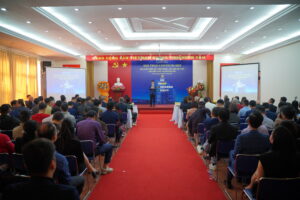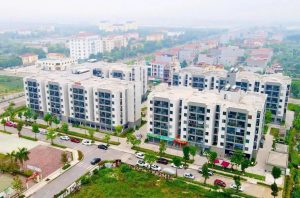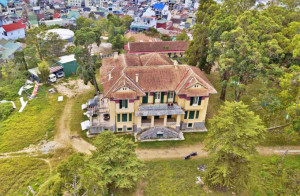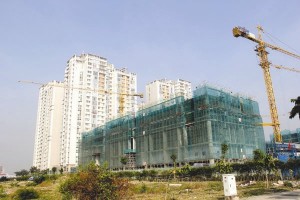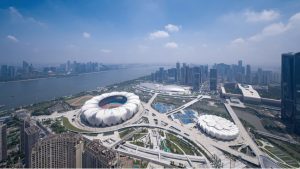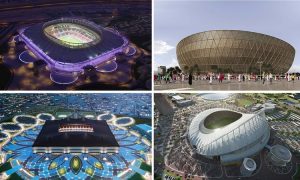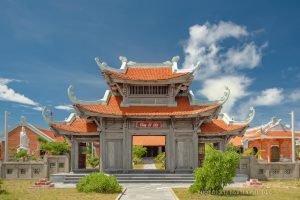Công bố quốc tế trong lĩnh vực kiến trúc, xây dựng (Tuần 1 tháng 9-2021)
Trong số này chúng tôi xin giới thiệu tới quý độc giả những nội dung chính của các công bố quốc tế đăng tải trên ScienceDirect và Springer Nature do Cục Thông tin khoa học và công nghệ quốc gia (NASATI) mua quyền truy cập như sau:
Quy hoạch đô thị:
– Tổng hợp một số đánh giá về dịch vụ hệ sinh thái cho quy hoạch đô thị: Đánh giá các phương pháp tiếp cận và đề xuất
– Số lượng hay chất lượng? Khám phá mối liên hệ giữa không gian mở công cộng và sức khỏe tâm thần ở đô thị Trung Quốc
– Mối quan hệ giữa trải nghiệm thời thơ ấu về thiên nhiên và sử dụng không gian xanh, sở thích cảnh quan, kết nối với thiên nhiên và hành vi vì môi trường
– Cây xanh thẳng đứng đệm có tác dụng giảm căng thẳng: Bằng chứng từ các phản ứng tâm sinh lý trong thực tế ảo
– Tầm quan trọng tương đối của các khía cạnh định lượng và định tính của không gian xanh đô thị trong việc tăng cường sức khỏe
– HoloDesigner: Một công cụ thực tế hỗn hợp cho thiết kế tại chỗ
– Nghiên cứu về việc mất carbon hữu cơ trong đất ngoại ô khi đô thị hóa siêu đô thị Thành Đô, Trung Quốc
– Sử dụng bản đồ nhu cầu để đánh giá lợi ích của không gian xanh và xanh đô thị ở các thành phố từ bốn châu lục
– Hiệu ứng quy mô và các động lực rõ ràng về mặt không gian của các tương tác giữa các dịch vụ hệ sinh thái — Một nghiên cứu điển hình từ Cao nguyên Hoàng thổ
– Mô hình hóa sự thoát hơi nước trong đô thị bằng cách sử dụng viễn thám, dấu chân thông lượng và trí tuệ nhân tạo
– Các kịch bản về di chuyển đô thị đến những năm 2030
Khoa học và công nghệ trong lĩnh vực kiến trúc, xây dựng:
– Phân tích độ ẩm và độ mặn của các công trình lịch sử trước và sau khi áp dụng các giải pháp khắc phục
– Phát triển phương pháp tiếp cận tự động đánh giá vòng đời dựa trên BIM cho các tòa nhà cao tầng được thiết kế theo mô-đun
– Hành vi thông gió của cửa sổ ảnh hưởng như thế nào đến khả năng phục hồi nhiệt trong các tòa nhà nhiều khu dân cư
– Cường độ thông gió của cửa sổ ảnh hưởng như thế nào đến khả năng phục hồi nhiệt trong các tòa nhà nhiều khu dân cư
– Phân loại và phân tích các ứng dụng học sâu trong xây dựng: Tổng quan tài liệu có hệ thống
– Khung tính toán tự động chi phí khắc phục vòng đời của các vết nứt lớp lót thứ cấp
– Lập bản đồ khoa học về nghiên cứu tòa nhà thông minh: Hướng tới một khuôn khổ hệ thống vật lý – mạng của con người (HCPS)
– Phương pháp điều phối robot xây dựng theo định hướng thông minh cho nhà tiền chế
Vật liệu xây dựng:
– Chất thải xây dựng được pha trộn nhẹ trong sản xuất vật liệu tổng hợp sáng tạo dựa trên xi măng để xây dựng bền vững
– Phân tích xây dựng theo giai đoạn của các tòa nhà bê tông cốt thép với các hệ thống chịu tải trọng bên khác nhau
– Đánh giá mức độ nguy hiểm của môi trường trong nhà dựa trên đặc điểm phát thải chất ô nhiễm lâu dài của vật liệu cách nhiệt xây dựng: Một nghiên cứu thực nghiệm
– Sử dụng tro đá phiến dầu làm vật liệu xây dựng: Rà soát có hệ thống
– Thực hiện hệ số thâm nhập mao quản về tính bay hơi của nước đối với vật liệu xây xốp: Nghiên cứu thực nghiệm
– Hệ thống hoàn thiện cách nhiệt bên ngoài sử dụng thạch cao gốc xi măng / vật liệu thay đổi pha vi bao để cải thiện hiệu suất lưu trữ nhiệt của tòa nhà
– Tính khả thi của tường lõi 3DP chịu tải trọng nén trong xây dựng thấp tầng
– Nâng cao hiệu suất chống địa chấn của các mô hình xây dựng được tăng cường bằng các vật liệu hiệu quả về chi phí dưới sự kích thích hai chiều
– Tổng hợp VO2 (M) hiệu quả để phát triển các vật liệu dựa trên xi măng nhiệt sắc tố cho các vỏ bọc tòa nhà thông minh
– Nhà tiền chế so với xây dựng thông thường: So sánh tác động vòng đời của các vật liệu kết cấu thay thế
Xin trân trọng giới thiệu!
QUY HOẠCH ĐÔ THỊ
- Synthesizing multiple ecosystem service assessments for urban planning: A review of approaches, and recommendations
Landscape and Urban Planning, Volume 213, September 2021, 104129
Abstract
While ecosystem service (ES) assessments become a more and more important source of knowledge, there is a need for synthesis approaches that make the results usable to support decisions. Effective synthesis approaches can reduce the information burden produced by multiple ES assessments and help decision-makers to compare alternative options and to assess their impacts. In this review, we focus on urban planning, one of the main decision-making processes that affect ES in cities, and investigate what synthesis approaches have been applied to support planning decisions. The aim is to identify the options available and to analyze their suitability to different urban planning decisions, thus providing a guidance to potential users.
We reviewed 62 studies selected through a search in two literature databases and identified six recurring synthesis approaches: diversity, average, weighted summation, multi-criteria analysis, optimization algorithms, and efficiency indicators; and a limited number of methods developed ad-hoc for specific applications. For each approach, we collected evidence about the appropriateness for different decision-making contexts, the applicability to different ES categories and types of assessment methods, and the occurrence of complementary analyses of ES interactions. Further, we built on the reviewed publications to identify pros and cons, including critical aspects related to the usability of the approaches, such as their complexity, transparency, and the level of stakeholder involvement. Based on the findings, we draw recommendations on how to select suitable synthesis approaches to support different urban planning decisions.
- Quantity or quality? Exploring the association between public open space and mental health in urban China
Landscape and Urban Planning, Volume 213, September 2021, 104128
Abstract
Public open space (POS) is a component of the urban built environment that is considered crucial for people’s mental health. Most studies, however, have focused on the quantity of POS, and those investigating the association between POS quality and mental health are limited. Through a 2018 survey of 590 residents and 160 POSs in Zhuhai, this study explored the association between both the quantity and quality attributes of POS and residents’ mental health in urban China. We employed an audit tool (POST) to measure POS quality and decomposed it into four attributes: activity, environmental quality, amenities, and safety. The statistical analyses suggest that POS quality is important for positive mental wellbeing, while, among the four attributes, activity and environment attributes are significantly associated with better mental health. The findings not only shed light on the potential mechanism of POS’ impact on mental health, but also help urban planners and policymakers develop an evidence-based approach to healthy cities.
- Relationships between childhood experience of nature and green/blue space use, landscape preferences, connection with nature and pro-environmental behavior
Landscape and Urban Planning, Volume 213, September 2021, 104135
Abstract
Nature exposure during childhood is thought to foster habits and preferences leading to greater nature exposure in adult life, thus providing an indirect route to increased mental and physical well-being, and greater engagement in pro-environmental behaviors (PEB). We explored the relationships between childhood nature experience (CNE) and time spent in nature, landscape preferences, biodiversity exposure, nature connection and willingness to engage in PEB as adults, using two data sets. Adults sampled in three New Zealand cities showed no significant association between CNE and time spent by adults in public and private green and blue spaces, nor with biodiversity exposure, as those with higher CNE scores did not select more biodiverse spaces to visit as adults. There were positive but weak associations between both age and the Nature Relatedness score, and nature contact. A second survey of young adults aged mostly between 18 and 25 years found only a weak association between CNE and willingness to engage in PEB, and similarly weak positive associations with scores representing participants’ awareness of the term “biodiversity” and strategies to improve biodiversity, the degree to which they valued biodiversity and urban green spaces, and their belief in the wellbeing benefits of nature for people. Time spent in nature during childhood was not a good predictor of time adults spent in natural spaces, landscape preferences or likelihood of PEB, suggesting that even where there is a deficit of childhood experiences adults can positively engage with nature in green and blue spaces.
- Vertical greenery buffers against stress: Evidence from psychophysiological responses in virtual reality
Landscape and Urban Planning, Volume 213, September 2021, 104127
Abstract
- Introduction
Rapid urbanization has been associated with decreased nature exposure (Cox et al., 2017, Turner et al., 2004) and increased environmental stressors like traffic noise and pollution (Verheij, Maas, & Groenewegen, 2008). Given that nature can combat stress and promote wellbeing (Bertram and Rehdanz, 2015, Hartig et al., 2014), there has been tremendous interests and collective efforts across the globe to increase urban greenspace such as trees, parks, and community gardens over the past few decades. It has been reported that from 1989 to 2009, 286 cities in China increased their average green space from 17% to 37% (Zhao et al., 2013), while 202 cities in Europe had an average annual increase of 0.54% in green space between 2000 and 2006 (Kabisch & Haase, 2013).
Vertical greenery refers to the integration of vegetation onto the vertical structures of buildings, which differs from green roofs that utilize the flat horizontal space atop buildings (Pérez, Coma, Martorell, & Cabeza, 2014). In the past, vertical greenery mainly consisted of self-climbing plants like vines that spread over buildings’ facades. However, recent contemporary structural systems have been developed that enable a wide variety of plants to be grown on and incorporated within vertical surfaces (Pérez-Urrestarazu, Fernández-Cañero, Franco-Salas, & Egea, 2015). Vertical greenery offers the potential to increase greenspace above-ground, thereby overcoming land constraints common in high-density urban areas (Jim, 2004). Vertical greenery provides important ecosystem services including the lowering of ambient temperature which reduces energy consumption from cooling systems (Alexandri & Jones, 2008), sound absorption which decreases noise pollution (Wong, Kwang Tan, Tan, Chiang, & Wong, 2010), and absorption of harmful pollutants which mitigates air pollution (Pandey, Pandey, & Tripathi, 2015). It further contributes to human health and wellbeing by providing exposure to nature in urban landscapes (Gillis & Gatersleben, 2015). Existing research on nature’s effects on emotion and stress has been dominated by natural environments such as parks and forests (Haluza et al., 2014, Hartig et al., 2014). Although there is growing research interest in urban forms of nature such as green roofs (e.g., Lee, Williams, Sargent, Williams, & Johnson, 2015), indoor plants and window views (e.g., Evensen, Raanaas, Hagerhall, Johansson, & Patil, 2013), no experimental study has been done to examine the psycho-physiological benefits of having a row of buildings covered in vertical greenery. We seek to fill this research gap by examining how concerted efforts to increase greenery among a cluster of buildings may benefit the psychological wellbeing of building occupants and passers-by.
Therefore, in this study we examined how vertical greenery on the exterior of buildings can affect emotion and buffer against stress. Our study extends current literature on nature exposure by investigating urban nature that spans across a row of buildings, and focuses on the understudied buffering effect of nature. We used virtual reality (VR) to conduct immersive and well-controlled experiments, avoiding confounding variables in field studies and teasing out the unique effect of nature. Past research has shown that the color green may produce anxiety-reducing effects (Kaya & Helena, 2004). We thus used green color walls instead of simply no vertical greenery in the control condition to show that nature can produce positive psychological effects beyond the effects of the color green. Our study aims to generate evidence suggesting that growing plants on a wall can result in better stress-buffering effects than simply painting a wall green.
- Relative importance of quantitative and qualitative aspects of urban green spaces in promoting health
Landscape and Urban Planning, Volume 213, September 2021, 104131
Abstract
The health benefits of urban green spaces (UGS) are important considerations in the design of urban environments. Researchers have analysed how the quantity of UGS impacts health outcomes, but less work has quantified the relative health benefits of different components of UGS provision. We examined the associations of different indicators of UGS provision with self-reported mental and general health based on a national representative household survey (n = 1000) in Singapore. We quantified three quantitative attributes of UGS (vegetation cover, canopy cover, park area) using Geographic Information System (GIS) data and measured visual greenness using the Green View Index (GVI) based on Google Street View panoramic images. We measured the subjective attributes of UGS, namely, usage quality and quantity of UGS within a 400 m circular buffer zone of residences using the survey. Among all the UGS indicators at the 400 m scale, only canopy cover and perceived usage quality were significantly associated with positive mental health, whereas none of the UGS indicators were related to general health. For visual greenness at different distance scales, there was a significant relationship between the indicator calculated by the sum of GVI at a 100 m scale and mental health. Canopy cover at a 400 m scale had a stronger correlation with mental health than perceived usage quality of nearby UGS and visual greenness at a 100 m scale. The findings highlight the importance of measuring both objective and subjective attributes of UGS provision and provide useful information for urban greening.
- HoloDesigner: A mixed reality tool for on-site design
Automation in Construction, Volume 129, September 2021, 103808
Automation in Construction
Abstract
Designing with the surrounding environment has been consistently encouraged in architectural design and urban planning since the modernist movement. However, on-site design work is challenging for designers, because the current design tools can hardly merge virtual three-dimensional (3D) models with real surrounding environments for visualization and interaction. To address this challenge, we designed and developed a mixed reality (MR) tool called HoloDesigner. In this paper, we describe the development process and core components of HoloDesigner. Through an on-site design application at a community park, we demonstrated its main workflow and functionalities. The results proved that HoloDesigner could successfully render on-site 3D visualization as well as real-time interactions to control 3D models in the real surrounding environment. This research offers new insights on supporting on-site design work with MR technologies and contributes to overcoming the limitations of current MR tools for on-site visualization and interaction.
- Loss of organic carbon in suburban soil upon urbanization of Chengdu megacity, China
Science of The Total Environment, Volume 785, 1 September 2021, 147209
Abstract
Urbanization is progressing rapidly. It can affect soils ecosystem services directly through land management and indirectly through changes in the socioeconomic environment, which eventually leads to an increase in emissions of greenhouse gases. Soil carbon (C) sequestration plays an important role in offsetting the anthropogenic C emissions. However, there is limited knowledge of how urbanization affects the soil C especially that in suburban. In this study, we studied changes in easily oxidizable organic C (EOC) and total organic C (TOC) of suburban soils (0–100 cm) in the rapid urbanising megacity Chengdu, China. The EOC stock and TOC stock decreased from the outer-suburb to the inner-suburb by 17.8–28.2% and 5.4–13.5%, respectively; particularly, the inner-suburb EOC decreased by 31.4–38.6% during the past 10 years. The quotient of EOC/TOC in the soil profile, reflecting the stability of soil C, declined from the outer-suburb (0.78) to the inner-suburb (0.20). Factors that influenced the EOC and TOC included the changes in economics (economic density, industrialization), farmland (cultivated area, farmland structure), urbanization (city size, population growth) and traffic flow. Among which, economic density growth was the primarily driver of the loss in TOC, explaining 31.6% of the variation in soil surface TOC and 16.0% of the variation in subsoil TOC; changes in farmland and urban expansion were the main factors contributing to the loss of subsoil EOC, with 40.4% explanatory ability. In addition, traffic flow also has contribution to the subsoil EOC loss. We concluded that the increasing soil C loss with decreasing distance from the city centre has a continuous contribution to C emission, and the C loss will persist until the suburbs are fully urbanized. The large losses of EOC and TOC caused by urbanization, and their contribution to global warming, necessitate their consideration in future appraisals of climate change and urban planning projects.
- Using demand mapping to assess the benefits of urban green and blue space in cities from four continents
Science of The Total Environment, Volume 785, 1 September 2021, 147238
Abstract
The benefits of urban green and blue infrastructure (UGI) are widely discussed, but rarely take into account local conditions or contexts. Although assessments increasingly consider the demand for the ecosystem services that UGI provides, they tend to only map the spatial pattern of pressures such as heat, or air pollution, and lack a wider understanding of where the beneficiaries are located and who will benefit most. We assess UGI in five cities from four continents with contrasting climate, socio-political context, and size. For three example services (air pollution removal, heat mitigation, accessible greenspace), we run an assessment that takes into account spatial patterns in the socio-economic demand for ecosystem services and develops metrics that reflect local context, drawing on the principles of vulnerability assessment. Despite similar overall levels of UGI (from 35 to 50% of urban footprint), the amount of service provided differs substantially between cities. Aggregate cooling ranged from 0.44 °C (Leicester) to 0.98 °C (Medellin), while pollution removal ranged from 488 kg PM2.5/yr (Zomba) to 48,400 kg PM2.5/yr (Dhaka). Percentage population with access to nearby greenspace ranged from 82% (Dhaka) to 100% (Zomba). The spatial patterns of pressure, of ecosystem service, and of maximum benefit within a city do not necessarily match, and this has implications for planning optimum locations for UGI in cities.
- Scale effect and spatially explicit drivers of interactions between ecosystem services—A case study from the Loess Plateau
Science of The Total Environment, Volume 785, 1 September 2021, 147389
Abstract
Identifying the scale effect of relationships between ecosystem services (ESs), and determining which factors affect such relationships and the spatial distribution patterns of these effects can assist in the sustainable management of ESs. Taking the Loess Plateau (LP) as a study area, we compared and analyzed the change in the trade-offs and synergies between four ESs (i.e. water yield, net primary production, soil conservation, and grain production) at seven different scales. In addition, the spatial correlations between these trade-offs/synergies and factors related to climate, vegetation restoration and urbanization at the county administrative scale were analyzed using a geographically weighted regression (GWR) model. The results showed that most relationships between ESs were synergistic and robust across all seven scales, and most correlations between ESs are enhanced as the scale increases, as a result of the “peak cutting and valley filling” process of scale synthesis. In addition, almost all the relationships between ESs had the strongest synergies or the weakest trade-offs at the municipality administrative scale. The occurrence of trade-offs/synergies between ESs was closely related to climatic factors, vegetation restoration factors and urbanization factors, and, in addition, properties and intensity of the correlations varied spatially. Among these factors, vegetation cover (VEG), annual average temperature (TEM), and construction land percentage (CLP) were more highly correlated with the trade-offs/synergies. This study contributes to extending our understanding of the way in which interactions between ESs depend on spatial scale, and could inform decision-makers about how to control various influencing factors to improve the local ecology under local conditions.
- Modeling urban evapotranspiration using remote sensing, flux footprints, and artificial intelligence
Science of The Total Environment, Volume 786, 10 September 2021, 147293
Abstract
As climate change progresses, urban areas are increasingly affected by water scarcity and the urban heat island effect. Evapotranspiration (ET) is a crucial component of urban greening initiatives of cities worldwide aimed at mitigating these issues. However, ET estimation methods in urban areas have so far been limited. An expanding number of flux towers in urban environments provide the opportunity to directly measure ET by the eddy covariance method. In this study, we present a novel approach to model urban ET by combining flux footprint modeling, remote sensing and geographic information system (GIS) data, and deep learning and machine learning techniques. This approach facilitates spatio-temporal extrapolation of ET at a half-hourly resolution; we tested this approach with a two-year dataset from two flux towers in Berlin, Germany. The benefit of integrating remote sensing and GIS data into models was investigated by testing four predictor scenarios. Two algorithms (1D convolutional neural networks (CNNs) and random forest (RF)) were compared. The best-performing models were then used to model ET values for the year 2019. The inclusion of GIS data extracted using flux footprints enhanced the predictive accuracy of models, particularly when meteorological data was more limited. The best-performing scenario (meteorological and GIS data) showed an RMSE of 0.0239 mm/h and R2 of 0.840 with RF and an RMSE of 0.0250 mm/h and a R2 of 0.824 with 1D CNN for the more vegetated site. The 2019 ET sum was substantially higher at the site surrounded by more urban greenery (366 mm) than at the inner-city site (223 mm), demonstrating the substantial influence of vegetation on the urban water cycle. The proposed method is highly promising for modeling ET in a heterogeneous urban environment and can support climate change mitigation initiatives of urban areas worldwide.
- Modification effect of urban landscape characteristics on the association between heat and stroke morbidity: A small-scale intra-urban study in Shenzhen, China
Science of The Total Environment, Volume 786, 10 September 2021, 147223
Abstract
Background
Short-term heat exposure might induce stroke morbidity and mortality, and there were several studies explored the possible vulnerable populations. At present, the research on the modification effect of intra-urban landscape characteristics on the association between heat and stroke morbidity is limited, especially in China.
Methods
We collected data on 22,424 first-ever strokes between 2010 and 2016 in Shenzhen, from June to August of each year. We adopted the case-only study combined with logistic regression models to examine the modification effects of 5 urban landscape characteristics. We studied the characteristics of relevant vulnerable populations through stratification analyses.
Results
High values (refer to the median values) of nighttime land surface temperature (LST) and the proportion of impervious surface may aggravate the harmful effects of heat on stroke morbidity, with the OR values (95% CI) of 1.205 (1.053, 1.357) and 1.115 (1.010, 1.220); while, high values of NDVI and the proportion of water bodies may alleviate the harmful effects of heat, with the OR values (95% CI) of 0.772 (0.699, 0.845) and 0.821 (0.741, 0.901). The OR value of daytime LST was 1.004 (0.861, 1.147). Statistically significant modification effects were located in the population without Shenzhen’s household registration; as for nighttime LST, statistically significant modification effects were located in females and the elderly.
Conclusions
High values of nighttime LST and the proportion of impervious surface might aggravate the harmful effects of heat on stroke morbidity, while high green space and water cover might alleviate its effects. Immigrants were the related vulnerable populations. The government should take measures to cope with climate warming and pay attention to the health effects of heat on immigrants.
- Urban experiments with public transport for low carbon mobility transitions in cities: A systematic literature review (1990–2020)
Sustainable Cities and Society, Volume 72, September 2021, 103023
Abstract
The development of public transport in cities can facilitate multiple ways under the Avoid-Shift-Improve (ASI) framework in reducing greenhouse gas (GHG) emissions from passenger mobility. Nevertheless, ensuring their integration and direction for moving toward low carbon mobility transitions is often challenging in practice. Urban experimentation has emerged as a governance model to foster innovations for climate change mitigation in cities while articulating a sustainable future. This paper aims to review how urban public transport experiments ensure the selection and consolidation of ASI measures to support low carbon mobility transitions. Our analysis is based on a systematic review of 41 documents gathered from peer-reviewed and grey literature databases. We find that experimentation is a critical platform for introducing novel ASI-public transport measures and exploring potential pathways toward the transitions through participative backcasting approaches. In our database, the experiments generally contribute to the rollout of LEV technologies and BRT systems, followed by the development of other ASI measures. Some of the experiments establish climate change targets to support low carbon mobility. Our review demonstrates that the experiments hold a pivotal role in developing niches for ASI-based measures and stimulating policy processes for the long-term transitions.
- Urban mobility scenarios until the 2030s
Sustainable Cities and Society, Volume 72, September 2021, 103029
Abstract
Urban mobility is particularly affected by technology development. This research focuses on the mobility system of cities in the foreseeable future – that is, until the 2030s. A systematic literature review (SLR) of 62 scientific documents and 52 scenarios predicted and developed by researchers are presented here, providing a comprehensive picture of current urban transport research perspectives. Based on a complex method built for this review, four scenarios (‘Grumpy old transport’, ‘At an easy pace’, ‘Mine is yours’, and ‘Tech-eager mobility’) have been created, each forecasting a different path towards future urban mobility. The scenarios so formed describe the expected role and potential of emerging mobility solutions (namely autonomous vehicles, shared mobility, and electrification) and include socio-economic and environmental perspectives. By 2030, most likely pathways are the ‘At an easy pace’ or the ‘Mine is yours’ scenarios, which means that only an incremental advance, such as a slow shift towards self-driving, electric and shared vehicle use is predicted.
- Sustainability of compact cities: A review of Inter-Building Effect on building energy and solar energy use
Sustainable Cities and Society, Volume 72, September 2021, 103035
Abstract
With the continuous advancement of urbanization, the impact of inter-building effect on urban energy use has been concerned. This paper makes a comprehensive review of the correlation between inter-building effect and building energy and solar energy use for the first time. For cities with different climate, the impact of inter-building effect on building energy consumption including cooling, heating, and lighting are discussed and quantitatively summarized. Besides, the review and discussion on the impact of inter-building effect on indoor thermal comfort shows that there is insufficient research and should be paid more attention in this field. From the different output forms of solar energy systems, the impact of inter-building effect on the BIPV system and STC system is also reviewed and quantitatively summarized. A concise summary of the research methods of the IBE is made and the software used for modeling is discussed. The review found that the influence degree of the inter-building effect varies greatly with different climatic zones. Considering the inter-building effect to guide early urban designing can greatly reduce building energy consumption and increase solar energy utilization. Some limitations of the current research, as well as general recommendations for the future are discussed. Future work requires engineers and scientists in the building industry and beyond to work together to contribute to the sustainable development of urban energy use.
- A comprehensive review on energy saving options and saving potential in low voltage electricity distribution networks: Building and public lighting
Sustainable Cities and Society, Volume 72, September 2021, 103064
Abstract
In recent years, energy saving has attracted the attention of researchers due to environment, energy, and reliability issues. Energy saving due to these advantages is one of the major steps toward sustainable cities and society. In this regard, the low-voltage section of the distribution system, including buildings and public lighting systems (PLSs), has great energy-saving potential. Accordingly, the present work reviews the potential of different energy-saving options and their environmental impact on buildings of different sectors and PLSs. In addition to direct energy-saving options such as using renewable energy sources and energy-efficient luminaries, available indirect options such as transactive energy, using energy storage systems and demand response programs are reviewed. For both the building and PLS sectors, available control strategies and technologies and related energy and emission saving potential are discussed. The detailed highlights of the previous works associated with the location of each research or experimental study are given in this review study. Finally, the key findings regarding the gap in the literature of the energy saving topic are discussed. This study is influential for policy-makers to take effective actions for energy saving through existing approaches and technologies, and is beneficial for researchers of the energy saving topic.
KHOA HỌC VÀ CÔNG NGHỆ TRONG LĨNH VỰC KIẾN TRÚC, XÂY DỰNG
1. Analysis of moisture and salinity of historical constructions before and after the application of REMEDIATIONS
Journal of Building Engineering, Volume 41, September 2021, 102785
Abstract
Negative effects of humidity in historic buildings can be considered as phenomenon that is perceptible on most of these constructions. Along with the problem of humidity, the salinity of wet walls can also be observed visually, that also in a large extent helps to destroy and gradually degrade particular structural elements and subsequently entire buildings. This article is going to describe the research dealing with the content of water-soluble salts and the degree of wetting on selected historical buildings in Slovakia. In the article are adduced the individual values of humidity measured at several places in the building and also describes the results of laboratory analyses of the amount of water-soluble salts in the investigated constructions. Subsequently, the article describes the technologies used in the rehabilitation of these structures and describes the effectiveness of these interventions against moisture, which are also presented by in situ measurements after the implementation of specific technologies.
2. Developing an automated BIM-based life cycle assessment approach for modularly designed high-rise buildings
Environmental Impact Assessment Review, Volume 90, September 2021, 106618
Abstract
Modular construction has attracted increasing attention due to its energy and environmental benefits. Digital technologies such as building information modelling (BIM) have also been explored to generate and manage data through the lifecycle of buildings. Although research has been performed in the area of integrating BIM and modular construction, BIM-based automated lifecycle assessment (LCA) of prefabricated buildings remains unexplored. This study therefore aims to develop a BIM-based LCA method for prefabricated buildings incorporating different assessment levels with unique system boundaries and functional units. The developed approach can support automated assessments through all lifecycle phases of a prefabricated building. It is achieved through an automated process of creating parameters to merge LCA data into the building model, systematic zoning, model setup and impact estimation. This approach is applied to evaluate the energy and environmental performances of a case building in Hong Kong. The case study validated the efficiency of the developed BIM-based LCA method in providing a systematic and detailed assessment of modularly designed buildings. This study extends the knowledge in automated BIM-based LCA by addressing specific characteristics of prefabrication and promotes the incorporation of comprehensive and detailed LCA data into BIM models for improved design robustness and holistic performances of buildings. This validated approach will enhance the willingness of designers to apply LCA during the design stages for minimizing the energy and environmental impacts of both new and renovated buildings with prefabrication.
- How window ventilation behaviour affects the heat resilience in multi-residential buildings
Building and Environment, Volume 202, September 2021, 107987
Abstract
To what extent is the overheating risk in dwellings affected by the individual window ventilation behaviour of residents? To answer this question six window ventilation profiles, obtained from surveys, are implemented in building performance simulation models of a large panel construction and a “Gründerzeit” multi-residential building located in Germany. The impacts of these different ventilation types are analysed for the top floor dwellings, including wind and temperature gradient-driven infiltration in the simulation. The results demonstrate the tremendous impact of the chosen window ventilation profile on overheating intensity. Low overheating is obtained if windows and room doors are fully opened, even if this is only done in the early morning and evening hours. Tilted windows are not adequate to ensure sufficient air exchange and lead to high overheating and critical room temperatures up to 35 °C. Regarding the building type, the above described effects are more pronounced in the “Gründerzeit” building whereas the large panel construction building exhibits a much higher heat resilience. However, overheated neighbouring dwellings shows a pronounced influence on overheating for the large panel construction building. Both findings can be attributed to building physics. In addition, the impact of meteorological conditions like tropical nights are found to significantly reduce the efficacy of passive cooling by nocturnal window ventilation. The overall findings clearly that a more accurate representation of natural ventilation is essential to draw correct conclusions from overheating assessments when using building performance simulation. In contrast, applying simplified natural ventilation boundary conditions in current overheating standards entails the risk of misinterpretations.
- Simulating the effect of sustainable buildings and energy efficiency standards on electricity consumption in four cities in Colombia: A system dynamics approach
Journal of Cleaner Production, Volume 314, 10 September 2021, 128041
Abstract
Buildings contribute to about 40% of direct and indirect greenhouse gas emissions and more than a third of energy consumption globally. Sustainable building standards and efficiency standards are two measures to reduce such emissions and energy consumption in buildings. While better standards improve the sustainability of new buildings, the impact of these actions depends on the ability to improve the existing building stock. Understanding the dynamics of adopting efficiency and sustainable building measures is essential for setting policy targets and mechanisms. This paper proposes a system dynamics model for assessing the energy savings potential from adopting sustainable building and energy efficiency measurements in buildings in systems with incomplete and uncertain information, using prospective scenarios. The model combines a dynamic diffusion model with an aggregate model for the building stock. The model is calibrated for estimating energy savings in the residential and commercial building stock of the four main metropolitan areas of Colombia: Bogotá, Medellín, Cali, and Barranquilla. Simulation results show that the maximum energy savings potential is approximately 12% but could be below 8% if rebound effects are considered. Results show that energy savings are limited if there are no policies for existing old buildings.
- Optimal ductility enhancement of RC framed buildings considering different non-invasive retrofitting techniques
Engineering Structures, Volume 242, 1 September 2021, 112572
Abstract
Existing RC framed buildings lack significant ductility, especially when they have been built with pre-code criteria. Improving their ductile capacity can help to prevent them from the brittle collapse mechanism and to reduce the seismic damage expected. This paper aims to investigate the enhancement of the ductile response behaviour of RC framed buildings considering different non-invasive retrofitting techniques. To do so, a pre-code RC framed school located in the Spanish province of Huelva has been selected as a case study. Five non-invasive retrofitting techniques have been tested: FRP wraps and steel jackets in columns, steel beams and plates under RC beams and single steel braces. They have been selected so that they can be easily implemented in the building. Some of them have been studied in detail in previous works and others have been included for further research in this paper. In order to compare the results obtained, the most typical technique in the seismic retrofitting of RC framed buildings, the addition of X-bracings in bays, has also been tested. Most previous studies on the seismic retrofitting of RC buildings are focused on validating a method based on artificial models. This paper compares the different techniques in terms of the capacity improvement and the damage reduction, performing analyses in detail and adding them in an existing RC building. A sensitivity analysis has been carried out to determine the influence of each technique in the building’s ductile capacity considering the finite element method. Nonlinear static analyses have been performed to obtain the capacity, the displacement ductility factor (μ) and the behaviour factor (q) of each model defined. The damage expected has been determined considering the ductile and fragile failure of the elements according to the Eurocode-8 (EC8) requirements. To analyse the suitability and the efficiency of each solution, a benefit/cost ratio has been obtained taking into account the ductility improvement and the damage reduction with regards to the retrofitting costs. The results have shown that the best benefit has been obtained with the addition of steel braces. However, the optimal solutions have been single braces and steel jackets due to their combination between benefit and cost. It has been observed that the solutions that increase the stiffness of the joints have had a higher improvement due to the key role that joints have in the resistant capacity of RC structurers. Also, it has been obtained that the values of the fundamental periods have been reduced, when adding the retrofitting elements and materials, up to 30% owing to the increase of the stiffness of the system. Finally, it must be highlighted that a detailed analysis of the behaviour of the whole building must be conducted in order to avoid additional rotation effects and shear forces that could worsen the building’s seismic behaviour. Existing RC framed buildings lack significant ductility, especially when they have been built with pre-code criteria. Improving their ductile capacity can help to prevent them from the brittle collapse mechanism and to reduce the seismic damage expected. This paper aims to investigate the enhancement of the ductile response behaviour of RC framed buildings considering different non-invasive retrofitting techniques. To do so, a pre-code RC framed school located in the Spanish province of Huelva has been selected as a case study. Five non-invasive retrofitting techniques have been tested: FRP wraps and steel jackets in columns, steel beams and plates under RC beams and single steel braces. They have been selected so that they can be easily implemented in the building. Some of them have been studied in detail in previous works and others have been included for further research in this paper. In order to compare the results obtained, the most typical technique in the seismic retrofitting of RC framed buildings, the addition of X-bracings in bays, has also been tested. Most previous studies on the seismic retrofitting of RC buildings are focused on validating a method based on artificial models. This paper compares the different techniques in terms of the capacity improvement and the damage reduction, performing analyses in detail and adding them in an existing RC building. A sensitivity analysis has been carried out to determine the influence of each technique in the building’s ductile capacity considering the finite element method. Nonlinear static analyses have been performed to obtain the capacity, the displacement ductility factor (μ) and the behaviour factor (q) of each model defined. The damage expected has been determined considering the ductile and fragile failure of the elements according to the Eurocode-8 (EC8) requirements. To analyse the suitability and the efficiency of each solution, a benefit/cost ratio has been obtained taking into account the ductility improvement and the damage reduction with regards to the retrofitting costs. The results have shown that the best benefit has been obtained with the addition of steel braces. However, the optimal solutions have been single braces and steel jackets due to their combination between benefit and cost. It has been observed that the solutions that increase the stiffness of the joints have had a higher improvement due to the key role that joints have in the resistant capacity of RC structurers. Also, it has been obtained that the values of the fundamental periods have been reduced, when adding the retrofitting elements and materials, up to 30% owing to the increase of the stiffness of the system. Finally, it must be highlighted that a detailed analysis of the behaviour of the whole building must be conducted in order to avoid additional rotation effects and shear forces that could worsen the building’s seismic behaviour.
- Classification and analysis of deep learning applications in construction: A systematic literature review
Automation in Construction, Volume 129, September 2021, 103760
Abstract
In recent years, the construction industry has experienced an expansion in the multitude of projects and emergent information. With the advent of deep learning, new opportunities have emerged for utilizing this vast amount of data to solve construction-related issues. While the use of deep learning has been increasing in construction, there has been no review on these applications to date. Therefore, this paper presents a Systematic Literature Review on the use of deep learning applications in construction. A total of 80 journal papers were identified and analyzed. Among these papers, six application-based topics were identified: equipment tracking, crack detection, construction work management, sewer assessment, 3D point cloud enhancement, and miscellaneous topics. Analysis shows that deep learning has been beneficial in leveraging data in areas such as crack detection and segmentation of infrastructure and sewers; equipment and worker detection and; and analysis and reporting on construction-related operations. Additionally, a discussion of the various deep learning techniques is provided as well as a contrast between deep learning, machine learning, and artificial intelligence.
- A framework for automatic calculation of life-cycle remediation costs of secondary lining cracks
Automation in Construction, Volume 129, September 2021, 103714
Abstract
This paper proposes the framework for automatic calculation of secondary lining cracks remediation costs. A study focuses on the structural cracks resulting from the tunnel secondary lining overloading due to rock mass creep. It is based on the multi-phase workflow combining the on-site measurements of behavior of the rock mass surrounding the tunnel and advanced numerical modelling tools assisted by the custom custom-made neural network, as well as the cost calculations. The workflow is established through the developed TunnCrack LCC platform where the data communication protocols between phases provided the straightforward and automatic data flow. Based on the evaluated long-term behavior of a tunnel, the secondary lining crack repair cost could be calculated for the different crack widths. The established platform presents a step forward in proactive estimation of the secondary lining remediation costs, where the monitoring data is continuously used to enhance the estimates of the crack repair costs, providing the tunnel managers with information on lining remediation life cycle costs, thus easing the overall decision-making process.
- A Scientometric mapping of smart building research: Towards a framework of human-cyber-physical system (HCPS)
Automation in Construction, Volume 129, September 2021, 103776
Abstract
This paper reviews the state-of-the-art smart building research by a bibliometric analysis, a content analysis, and a qualitative review. The bibliometric analysis of 364 academic papers shows that smart building is a burgeoning, interdisciplinary field with a relatively high international collaboration level. Keyword’s clustering identified two major themes: (1) IoT, WSN, and cloud computing for automation control and (2) the balance between energy efficiency and human comfort based on continuous monitoring and machine learning. The content analysis statistically detected a transition from the cyber-physical system (CPS) to the human-cyber-physical system (HCPS) in smart building research. We therefore proposed an HCPS framework with three dimensions—cyber-physical scale, human needs, and human roles—to summarize current research and discover potential gaps. Under this framework, five HCPS future research directions for occupants-centered smart buildings were proposed: adaptive building envelope, integrated building management system, enhanced building energy management, adaptive thermal comfort, and microgrid adoption.
- Smart component-oriented method of construction robot coordination for prefabricated housing
Automation in Construction, Volume 129, September 2021, 103778
Abstract
Although achievements have been made in research on robotic construction for specific construction tasks, robots are still not capable of working together to accomplish multiple construction tasks. To achieve this goal it is necessary to study how to realize robot coordination in prefabricated construction. In this paper, we propose a component-oriented robot construction approach. Using the smart construction object (SCO) approach, diverse construction tasks are assigned to robots by assigning state and requirements to the components to drive multiple robots for the assembly of prefabricated housing. Within a prototype BIM simulation environment, we implemented multiple different robots to complete the construction of a steel frame based on the SCOs. For more realistic robot-base construction design, the next step is the introduction of more complicated BIM models and more accurate robot models to enable collaborative simulation of a wider variety of prefabricated construction processes.
- Logic representation and reasoning for automated BIM analysis to support automation in offsite construction
Automation in Construction, Volume 129, September 2021, 103756
Abstract
- Introduction
In the past decades, a concerning labor shortage is experienced by the labor-driven Architecture, Engineering, and Construction (AEC) industry [[1], [2], [3]]. For instance, in the United States, 80% of the construction companies cannot find trades workers to fill job positions [4]. Just for January of 2020, 267,000 unfilled construction positions were reported in the U.S. [5]. This problem has impacted negatively the productivity in the AEC industry, causing delays and cost overrun in construction projects [6]. In a survey conducted by Construction Labor Market Analyzer, more than 90% of the respondents reported a lower productivity for the years 2014 and 2015 due to the labor shortage [6].
Technologies such as offsite construction and automation allow greater efficiency by automating construction processes, which can be translated into higher productivity in the industry. This increase in productivity can relieve some of the strain imposed by the workforce shortage [[7], [8], [9]]. On the one hand, offsite construction provides many benefits over conventional stick-built construction such as working in a controlled environment, the ability to conduct activities in parallel, and improvement of the built quality [[10], [11], [12]]. Automation in construction, on the other hand, includes the application of technologies such as Computer Numerical Control (CNC), robotics, and other automation machines that could be easier to implement in a factory setting than in onsite construction. For example, these technologies can be adopted to support the fabrication and assembly of building components by automating otherwise manual operations. Moreover, automation can improve safety by saving workers from dangerous and heavy-duty tasks and/or in hazardous conditions.
However, despite these benefits, there are many challenges with the automation of offsite construction in practice. One main challenge is that offsite construction demands more rigorous design, planning [13], and construction requirements than those of onsite construction. For example, the design, manufacturing, and assembly tolerances for offsite construction are tighter than those for stick built because the assembled components need to appropriately fit the prepared foundation rather than the components sequentially erected onsite, in which the latter option allows more flexibility for local adjustments of the connections between the frames and the foundation. In addition, automation requires detailed and precise information such as building information models, material, and building systems to obtain the desired outcomes [14]. These challenges have impeded the wide adoption of automation in offsite construction.
Building Information Modeling (BIM) has the potential to overcome these limitations and enable automation in construction by providing detailed, precise, and complete information as input for automation technologies in the context of offsite construction [14]. However, the support of BIM for offsite construction is still limited in the current digital workflow. For instance, BIM lacks the capability to represent complex buildings or to plan for automated processes in offsite construction [15]. Therefore, to address this gap, the authors propose a method to facilitate the automation of wood construction by automatically analyzing building design information to obtain construction operational level information from the analysis so that it can be further used to feed into construction automation technologies. The proposed method utilizes a logic enabled approach to extract and infer information from IFC-based BIM instance models. The method involves the development of: (1) a set of algorithms (using logic rules) for the automated information extraction and properties inference, (2) representation of the IFC-based BIM instance models into logic facts, and (3) the logic reasoning using the logic rules and facts.
- Three cooperative robotic fabrication methods for the scaffold-free construction of a masonry arch
Automation in Construction, Volume 129, September 2021, 103803
Abstract
Geometrically complex masonry structures (e.g., arches, domes, vaults) are traditionally built with scaffolding or falsework to provide stability during construction. The process of building such structures can potentially be improved through the use of multiple robots working together in a cooperative assembly framework. Here a robot is envisioned as both a placement and external support agent during fabrication – the unfinished structure is supported in such a way that scaffolding is not required. The goal of this paper is to present and validate the efficacy of three cooperative fabrication approaches using two or three robots, for the scaffold-free construction of a stable masonry arch from which a medium-span vault is built. A simplified numerical method to represent a masonry structure is first presented and validated to analyze systems composed of discrete volumetric elements. This method is then used to evaluate the effect of the three cooperative robotic fabrication strategies on the stability performance of the central arch. The sequential method and cantilever method, which utilize two robotic arms, are shown to be viable methods, but have challenges related to scalability and robustness. By adding a third robotic agent, it becomes possible to determine a structurally optimal fabrication sequence through a multi-objective optimization process. The optimized three robot method is shown to significantly improve the structural behavior over all fabrication steps. The modeling approaches presented in this paper are broadly formulated and widely applicable for the analysis of cooperative robotic fabrication sequences for the construction of masonry structures across scales.
12. Hybrid machine learning for pullback force forecasting during horizontal directional drilling
Automation in Construction, Volume 129, September 2021, 103810
Abstract
This paper presents a hybrid machine learning model for predicting the pullback force in horizontal directional drilling (HDD) construction. The model combines the nondominated sorting genetic algorithm II (NSGA-II) and support vector machine (SVM). NSGA-II is used to optimize two hyperparameters in SVM. Different from other optimization algorithms, NSGA-II is a multi-objective optimizer, which considers prediction accuracy and stability. The proposed model is applied to two practical HDD projects in China. The prediction result is compared with the actual monitoring data, which shows that the mean absolute percentage errors (MAPE) are less than 7%. The primary conclusions are as follows: (1) The proposed model’s accuracy and stability are better than those of the two benchmark models; (2) Machine learning models can predict the pullback force more accurately than the empirical model in the construction phase, and the maximum MAPE does not exceed 17%; (3) The running time of the proposed model is short, and it is feasible in practical application. Moreover, this paper discusses the practical application of machine learning models in HDD construction and the future development direction.
13. Vision-based method of automatically detecting construction video highlights by integrating machine tracking and CNN feature extraction
Automation in Construction, Volume 129, September 2021, 103817
Abstract
Automatic analysis of construction video footage is beneficial for project management tasks such as productivity analysis and safety control. However, construction videos are usually long in duration and only contain limited useful information to engineers, while the storage of video data from construction projects is challenging. To obtain and store useful video footage systematically and concisely, this research proposes a vision-based method to automatically generate video highlights from construction videos. The proposed approach is validated through two case studies: a gate scenario and an earthmoving scenario. In experiments, the proposed method has achieved 89.2% on precision and 93.3% on recall, which outperforms the feature-based method by 12.7% and 17.2% on precision and recall, respectively. Meanwhile, the proposed method reduces the required digital storage space by 94.6%. The proposed approach offers potential benefits to construction management in terms of significantly reducing video storage space and efficiently indexing construction video footage.
14. Digital management focused on the preventive maintenance of World Heritage Sites
Automation in Construction, Volume 129, September 2021, 103813
Abstract
The digital management of heritage buildings is a new disruptive technology in the design and implementation of effective preventive preservation strategies and programmes that can manage data from such buildings and the knowledge of professional experts in the area. At heritage sites, preventive conservation requires multidisciplinary knowledge of historical heritage diagnosis; therefore, professional experts’ assessments are essential. This paper presents the application of an innovative fuzzy inference system that can quantify the vulnerabilities and risks that face World Heritage Sites, as well as their functional service life. This work can help stakeholders develop innovative procedures and improve mitigation strategies, such as preventive maintenance programmes and future control systems for maximising the resilience of specific heritage complexes. To validate this innovative approach, one of the most iconic heritage buildings was used as a case study: the Royal Alcázar of Seville, Spain.
15. Post-disaster reconstruction supply chain: Empirical optimization study
Automation in Construction, Volume 129, September 2021, 103811
Abstract
This research proposes the development of a resilience location-routing model for Post-Disaster Reconstruction Supply Chain (PDRSC) endeavors under a government-funded project and cooperation of government and private companies, which can (i) optimize the allotment of restricted reconstruction resources to damaged areas; (ii) minimize the costs of location, routing, and disruption in the post-disaster reconstruction circumstances; (iii) evaluate and determine the total performance loss of damaged distribution networks during recovery processes; (iv) appraise the effect of limited access to resources on reconstruction costs; and (v) minimize the efficiency loss of distribution networks and reconstruction costs associated with providing resources. Furthermore, a real-case study is investigated to evaluate the application of the model. This study contributes to the literature on the optimization-based design of reconstruction networks under disruption risks and supports informed decision-making by regional authorities to enhance the resilience of urban areas to cope with the damages of destructive catastrophes.
- Project scheduling and material ordering problem with storage space constraints
Automation in Construction, Volume 129, September 2021, 103796
Abstract
Since the storage space for materials is often limited in reality in many construction sites, a bi-objective optimization model for the project scheduling and material ordering problem (PSMOP) with limited storage space is proposed in this paper. The model is able to determine the activity schedule and the material ordering time and quantity through minimizing the makespan of the project and the corresponding costs including the material inventory cost, the ordering cost and the indirect cost. The presented model is NP-hard, so the non-dominated sorting genetic algorithm (NSGA-II), tuned by the Taguchi method, is suggested to serve as the solution methodology. Furthermore, after the validation of efficiency and convergence of the NSGA-II, computational experiments are conducted to demonstrate the effects of the unit cost and the storage space on the Pareto frontier.
- HEAP – The autonomous walking excavator
Automation in Construction, Volume 129, September 2021, 103783
Abstract
The demand and the potential for automation in the construction sector is unmatched, particularly for increasing environmental sustainability, improving worker safety and reducing labor shortages. We have developed an autonomous walking excavator – based one of the most versatile machines found on construction sites – as one way to begin fulfilling this potential. This article describes the process of converting an off-the-shelf construction machine into an autonomous robotic system. First we outline the necessary sensing equipment for full autonomy and the novel actuation of the legs, and compare three different complementary actuation principles for the excavator’s arm. Second, we solve the state estimation problem for a general wheeled-legged robot. Beside kinematic measurements, it includes GNSS-RTK, to absolutely reference the machine on a construction site. Third, we developed individual controllers for driving, chassis balancing and arm motions allowing for fully autonomous operation. Lastly, we highlight the machine’s potential in four different real-world applications, e.g. autonomous trench digging, autonomous assembly of dry stone walls, autonomous forestry work and semi-autonomous teleoperation. On top, we also share some development insights and possible future research directions.
VẬT LIỆU XÂY DỰNG
- Environmental impact of construction transport and the effects of building certification schemes
Resources, Conservation and Recycling, Volume 172, September 2021, 105688
Abstract
The construction industry is associated with low productivity growth rates and environmental harm and, has a crucial role to play to reach the SDGs adopted by the UN in 2015. Construction logistics offer useful solutions to improve both the productivity and sustainability of the industry. The purpose of this paper is to investigate, in detail, the environmental impact of construction transport and whether the building certification scheme for a construction project has any influence on its transport arrangements. The analysis in this paper is based on a multiple case study of 40 Swedish projects. The results show that construction projects with better environmental ratings generated less emissions from construction transport. However, among the ten projects with highest transport/m2, five were certified. Construction logistics solutions (CLSs) such as terminals and checkpoints are useful in reducing the number of transports, and thereby reducing emissions. But the usefulness of a CLS is influenced by gross floor area and type of project, as well as the phase which the solution is implemented in. This study contributes to a better understanding of construction transport patterns and reducing environmental harm of these transports. The results of this paper are beneficial for construction site managers, logistics consultants and transport companies, helping them to implement CLSs in a more useful way, depending on the phase and type of project.
- Lightweight blended building waste in the production of innovative cement-based composites for sustainable construction
Construction and Building Materials, Volume 299, 13 September 2021, 123933
Abstract
Intensive quarrying of natural non-renewable resources belongs to the actual topics related to the dynamically developing construction industry worldwide. However, at the same moment, an appreciable quantity of construction and demolition waste (CDW) is generated, from which the primacy to concrete, ceramic and masonry derived materials is attributed. These are already traditionally applied in concrete manufacturing as supplementing and filing materials due to their good recycling ability. Nevertheless, a number of material blends which separation is complicated or highly financial demanding still remain and thus burden our environment. This work has been aimed at the effective application of lightweight blended building waste (LBW) in the manufacturing of eco-friendly concretes. Concrete mixtures with the volumetric content 0–100% of the waste blend have been prepared. The influence of LBW on 28 days’ water cured samples has been investigated with the application of a wide range of experimental procedures and various instrumental techniques. Performed tests revealed a substantial lightening effect of LBW – leading to hardened concretes with a unit weight of about 760 kg·m−3. On the other hand, a high rate of lightening caused considerable decrease in strength properties of produced composites. However, application of LBW up to 25% can be used to preserve usage of these blended concretes for construction applications. Other performed tests showed excellent thermal performance of waste aggregate enriched concretes, and thus these materials may find usage for special filling and flooring applications with minimum loading of bearing structures.
- Staged construction analysis of reinforced concrete buildings with different lateral load resisting systems
Engineering Structures, Volume 242, 1 September 2021, 112535
Abstract
Lateral load resisting systems (LLRS) in reinforced concrete (RC) buildings should be adequately determined to control their response under lateral and gravity loads. Practitioners used to select the LLRS using one-step analysis (OSA) by assuming both the lateral and gravity loads are applied at one stage to a complete building. Instead, staged-construction analysis (SCA) should be adopted because RC buildings are constructed in different stages and the gravity loads act sequentially. In this research, a nonlinear finite element model for SCA of RC buildings is developed and validated using a robust commercial software. The developed model is extended to account for time dependent effects (SCAT) such as shrinkage, creep, and strength gain. The model is utilized to analyze eight RC buildings with different heights and LLRS. Design parameters for the studied buildings are proportioned to satisfy both the working and ultimate state design criteria. Differential displacements and straining actions in horizontal elements as well as shortenings in vertical elements are estimated using SCAT and then compared to their counterparts obtained from OSA. SCAT yielded shortening and differential displacements larger than those obtained from OSA by a percentage that reached 143%, 153%, 116%, and 154% for buildings with rigid frame, shear wall, wall-frame, and tube in tube LLRS, respectively. Increase in straining actions obtained from SCAT ranged between 26% and 554% more than those obtained from OSA. Decrease in straining actions obtained from SCAT ranged between 26% and 71% less than those obtained from OSA.
- A life cycle analysis of ionizing radiation shielding construction systems in healthcare buildings
Journal of Building Engineering, Volume 41, September 2021, 102387
Abstract
Optimization of material resources, energy efficiency and reduction of environmental impact are basic aspects in selection of a construction system. The aim of this study is to evaluate the environmental impact generated by different shielding systems for walls of an X-ray room in healthcare buildings. Eight commercial construction systems for anti-X shielding were analysed. A Life Cycle Assessment (LCA) was performed by SimaPro using the Ecoinvent database, and a single-score damage category analysis was performed for midpoint and endpoint levels. Prices of installation and working time employed in the construction of a functional unit of each system were obtained. Solutions with clay brick, cast-in-place reinforced concrete and sprayed concrete were the most favourable for the different categories. Sprayed concrete obtained 6.739 points/m2 of against 165.12 points/m2 of rolled steel option. The damage to human health occupies between 41% and 87% of the total impact in the protection areas. The impact category of human toxicity is also the broadest in the midpoint approach. Considering time and cost of implementation, clay brick solutions proved to be the most favourable, along with cast-in-place reinforced concrete and barite concrete. System #6 is the most environmentally friendly, 1.6 times less than the next one (which is #4), although its unit price is 1.94 times the cheapest (which is #2) and its execution time is 1.89 times the lowest (which is #2 again). The knowledge generated in this study will improve investment decision making for the planning departments of the Sanitary Systems, obtaining an economic, social and environmental benefit. The main novelty of the work lies in the object of the study (X-ray room) as well as in the integration of LCA and economic aspects.
- Hazard evaluation of indoor environment based on long-term pollutant emission characteristics of building insulation materials: An empirical study☆
Environmental Pollution, Volume 285, 15 September 2021, 117223
Abstract
Insulation materials are essential components in construction, and their main objective is to increase the efficiency of thermal energy by minimizing internal and external thermal exchange. Accordingly, research and development studies are being actively conducted to increase the thermal resistance of insulation materials, and high-performance insulation materials that use organic chemicals have been developed after industrialization. However, thermal insulation comprising chemicals poses a potential risk of pollutant emissions and can cause health problems. In this study, five types of insulation materials and the contaminants generated from the building materials used in insulation construction were quantitatively analyzed. In addition, an empirical study on the discharge of pollutants was conducted using a test bed, and the effects of the pollutants discharged from the insulation material on the indoor environment were examined by analyzing the pollutant concentration for 90 days. In addition, we analyzed the effect of an insulation material on an indoor environment through the standard specifications. Moreover, the necessity of legal management of the emission of contaminants from insulation materials was proposed based on the empirical research results.
- Utilizing of oil shale ash as a construction material: A systematic review
Construction and Building Materials, Volume 299, 13 September 2021, 123844
Abstract
Oil shale ash (OSA) is proven as a self-cementitious material that consists of two parts; a cementitious part represented by its high content of CaO, and a Pozzolanic part represented by its content of Al2O3, SiO2, and Fe2O3. OSA can be used in the various applications of the construction industry and building technology to minimize environmental risks and promote sustainability. This review aims to survey the research efforts on using OSA for construction applications and map the research views from the literature through a coherent and systematic mixed reviewing methodology (bibliometric analysis and systematic review). Overall, 528 publications were collected and then screened to 38 studies. The bibliometric mapping was implemented for the keyword’s occurrence and the tested properties of construction materials containing OSA. This review concluded that the utilization of OSA in construction materials has considerably interesting pathways and presents a basis for future optimization in concrete, mortar, geopolymer, building blocks, glass–ceramic, aggregate, asphalt binder, and soil stabilization agent. However, this utilization negatively affects several aspects of each type of the reviewed material. More investigations are required to provide a better understanding of the mechanical properties and durability of OSA-based concrete for its mass usage in broad applications and widespread in the construction industry. This systematic review provides a thorough understanding of gaps and existing opportunities for research and is expected to motivate researchers to be involved in this range of studies.
- Implementation of capillary penetration coefficient on water sorptivity for porous building materials: An experimental study
Construction and Building Materials, Volume 298, 6 September 2021, 123758
Abstract
Neutron radiography is used to study the relation between water sorptivities (s) and capillary penetration coefficient (k), and to reveal impacts of sealing method on the water absorption process in brick samples. Except for the ends, the samples’ outer surfaces were coated with a polymeric waterproofing slurry. While the samples were absorbing water, neutron radiography images were recorded continuously. Analyses of the acquired images, as well as published results for construction building materials, were used to determine water sorptivities (s), capillary penetration coefficient (k), and capillary porosity (θc). The results showed that s is proportional to k in a direct manner, and that θc is the proportionality constant. It was found that samples coated with a polymeric waterproofing slurry absorb water more quickly than samples coated with acrylic paint.
- Hemp-lime buildings: thermo-hygrometric behaviour of two case studies in North and South Italy
Energy and Buildings, Volume 247, 15 September 2021, 111147
Abstract
In the framework of Circular Economy policies aimed at reducing the consumption of raw materials, shives, an agricultural by-product of hemp cultivation, have gained a renovated life in the construction sector; new building materials, suitable for various executive techniques, have been developed exploiting the excellent thermal insulating properties of shives. When this vegetal material is mixed with a mineral binder such as lime or cement, the mixture is usually referred to as hemp-lime. In Italy, the use of hemp-lime blocks and the development of new production chains dates back only to about the last decade, while other European countries have more long-lasting experiences. In order to assess the potential benefits of hemp-lime blocks in the construction sector, it is necessary to evaluate the performance of these materials in situ, i.e. on the construction site, to obtain fundamental data to ensure that consumers and designers receive trustworthy and relevant information on products and their durability.
This research work aims to be a solid base for the development of future guidelines and/or regulations at national and international level, in order to guarantee the maximum diffusion of this type of product. Then, a study plan has been carried out regarding the functionality of hemp-lime blocks in masonry, layered with finishing plaster made of fine hemp shives, to evaluate the in situ thermo-hygrometric building performance. In particular, experimental methods were developed and measurements were carried out on two structures, one in northern Italy and one in southern Italy, and precisely in Sicily, focusing the study on the performances of the walls subjected to warm Mediterranean climates.
- A circular construction evaluation framework to promote designing for disassembly and adaptability
Journal of Cleaner Production, Volume 316, 20 September 2021, 128122
Abstract
This paper formulates a concise, free-to-use Circular Construction Evaluation Framework (CCEF) based upon international design code guidelines to assess and quantify the circularity credentials of an existing or proposed construction project. Central to the principles of circular construction is designing for disassembly and adaptability – the ability of a building’s elements and connecting components to be disassembled and reused, or rearranged, after the initial design life. Analysis of modern methods of construction and the compatibility of systems with the concepts of designing for disassembly and material reuse inform the development of the CCEF. Circular construction is facilitated by simplicity, standardisation and modularity in design, sustainably-sourced materials, transparent and accessible mechanical connections and the adoption of a manufacturing-style approach towards durable and reusable standardised components and materials. The CCEF allows users such as clients, consultants, contractors, local and national planning and infrastructure policy professionals to evaluate both whole building and elemental levels at the early design and planning stages in a new-build, refurbishment or renovation project. Implementation of a scoring system is demonstrated by the evaluation of example buildings with varying usage of conventional and bio-based materials. It is shown by use of the framework that a simple standardised construction using reversible connections and previously used material elements rates highly, demonstrating a greater extent of circularity in the construction.
- Exterior insulation finishing system using cementitious plaster/microencapsulated phase change material for improving the building thermal storage performance
Construction and Building Materials, Volume 299, 13 September 2021, 123932
Abstract
Among the construction methods used for the construction of buildings, exterior insulation finishing can effectively utilize the thermal energy of a building as it prevents the occurrence of thermal bridges, unlike internal insulation. Recently, along with the global energy saving efforts, building energy saving methods, which effectively use the heat energy in buildings, have emerged. However, the development of superior insulation materials, such as aerogels and vacuum insulation materials, have attracted significant attention. In this study, we optimized the external insulation plastering method using a phase change material (PCM) to improve the efficiency of thermal-energy use and prepared a mortar/microencapsulated PCM (MPCM) composite specimen for use in the external insulation plastering method. Herein, various analyses were conducted to evaluate the prepared specimen, including scanning electron microscopy, differential scanning calorimetry, thermogravimetric analysis, and Fourier transform infrared spectroscopy. The results showed that even if only 10 wt% of MPCM was used, the time-lag effect was improved by 59.4%, indicating excellent thermal storage performance. Therefore, we believe that the use of proposed MPCM can achieve significant thermal performance improvement when applied to various mortar areas in buildings.
- Feasibility of 3DP cob walls under compression loads in low-rise construction
Construction and Building Materials, Volume 301, 27 September 2021, 124079
Abstract
The rapid adoption of 3D-printing (3DP) technologies in construction, combined with an increased willingness to reduce environmental impact, has facilitated reapproaching earth materials for modern building industry. The feasibility of 3DP earth-based materials has been under investigation in recent years, with a particular focus on cob due to its favourable characteristics toward the 3DP process. Yet, there is a lack of definitive information on the construction of 3DP cob. Hence this paper investigates the structural feasibility of 3D-printed cob walls in low-rise buildings. The investigation involved experimental compression tests on 3DP cob samples to obtain key mechanical properties including the compressive strength and elastic modulus. These properties were then used as inputs for structural analyses with respect to three alternate types of 3DP cob wall patterns to evaluate their load-carrying capacity based on a limit-state design framework. Results from the analyses were implemented in modelling an idealised low-rise cob building covering a range of floor spans and wall heights. The analytical study found that 3D-printed walls have the potential to sustain gravity loads typical of residential construction. Further, since the 3DP material was shown to have similar mechanical performance to conventional (non-3DP) cob on the material scale, the 3D-printing process provides the opportunity to produce wall sections that are structurally more efficient than the solid section used in conventional cob construction. This results in lower material consumption, making 3DP cob attractive from the point of view of resource efficiency. An important outcome of the study is the demonstration of a model design technique for low-rise 3DP cob buildings that could be implemented as part of a broader optimisation procedure to satisfy structural and architectural design objectives.
- Seismic performance enhancement of masonry building models strengthened with the cost-effective materials under bi-directional excitation
Engineering Structures, Volume 242, 1 September 2021, 112516
Abstract
Unreinforced masonry (URM) buildings are prone to severe damage during an earthquake. A total collapse of these structures was witnessed in the past seismic events. Hence, the present study aims to enhance the seismic performance of single-storied scaled-down building models by strengthening with two cost-effective materials; polypropylene (PP) band and steel wire mesh. This is a quick and straightforward process which was followed for the strengthening purpose. Half-scale size of clay and fly-ash bricks were used for making the test specimens. Both URM and strengthened building models were subjected to bi-directional swept sine motion. Each damaged state of building models was reported during the loading sequence. The crack progressions and failure characteristics of the building models were thoroughly observed. Furthermore, arias intensity, acceleration amplification factor, and performance evaluation indices were determined forabetter understanding of the seismic response of the models. It was noticed that both the strengthening materials were effective and economical in improving the performance (strength, global stiffness, damage tolerance) of masonry building models adequately.
- Efficient VO2(M) synthesis to develop thermochromic cement-based materials for smart building envelopes
Materials Chemistry and Physics, Volume 269, 1 September 2021, 124765
Abstract
The buildings constructions up to now have been shown to require a high energy consumption in their everyday functioning. In this sense, thermochromic materials are being studied to reduce the energy demands by improving the buildings energy efficiency and minimizing the heat island effects. They are smart materials that change their optical properties with temperature. The working principle for this application is based on thermochromic materials that promote the solar reflection in the building envelope in warm weather to limit the building overheating, and to facilitate the absorption in cold weather to transfer heat into the building. For this purpose, VO2(M), which has already been applied for smart windows, is being investigated to be applied for the thermochromic functionalization of buildings opaque components. This paper aims to study the more adequate VO2(M) production to be applied in cement-based materials for building envelopes. The synthesis of VO2(M) powder through hydrothermal synthesis routes is studied considering the most efficient and sustainable conditions. For this purpose, the VO2(M) one-step hydrothermal synthesis, starting from V2O5 and H2C2O4 precursors and performed at 240 °C is considered. The major objective is to provide a clearer definition of the hydrothermal synthesis parameters to produce VO2(M) with those conditions. The effect of the molar ratio of the precursors, their solid concentration and the synthesis time was analysed. Moreover, the two-step synthesis through VO2(D) transformation was also reproduced to compare the morphology and properties of the obtained products. X-ray diffraction and differential scanning calorimetry were done in the synthesized products to study the structural phase and the thermochromic transition, respectively. Results showed that the molar ratio of the precursors was shown to be a determining factor in the VO2(M) one-step synthesis, and that the obtained powder presented lower agglomeration in the one-step as compared with the two-step synthesis.
- Prefabricated versus conventional construction: Comparing life-cycle impacts of alternative structural materials
Journal of Building Engineering, Volume 41, September 2021, 102705
Abstract
Prefabrication can have advantages in terms of materials and time efficiency, but the overall environmental and cost trade‐offs between the two construction methods are unclear and influenced by the choice of the structural material. A life cycle assessment was carried out to compare two constructive systems (prefabrication and conventional) and different structural materials for a single-family house. Impacts, waste, costs, and production time were assessed for two prefabricated construction systems – lightweight steel frame (LSF) and wooden frame (WF) – and two conventional construction systems – reinforced concrete (RC1) with a single layer concrete block or with a double-layer brick external wall (RC2). Results showed that WF has the lowest impacts followed by LSF, and that embodied impacts can represent more than half of total impacts. Prefabricated houses have up to 65% less embodied impacts, and end-of-life impacts of prefabricated LSF are lower due to recycling; thus, unveiling the importance of embodied and end-of-life phases. Prefabrication can decrease impacts, materials consumption, and waste generation, pushing forward circularity within the construction sector.
- The role of lignin and lignin-based materials in sustainable construction – A comprehensive review
International Journal of Biological Macromolecules, Volume 187, 30 September 2021, Pages 624-650
Abstract
The construction industry in the 21st century faces numerous global challenges associated with growing concerns for the environment. Therefore, this review focuses on the role of lignin and its derivatives in sustainable construction. Lignin’s properties are defined in terms of their structure/property relationships and how structural differences arising from lignin extraction methods influence its application within the construction sector. Lignin and lignin composites allow the partial replacement of petroleum products, making the final materials and the entire construction sector more sustainable. The latest technological developments associated with cement composites, rigid polyurethane foams, paints and coatings, phenolic or epoxy resins, and bitumen replacements are discussed in terms of key engineering parameters. The application of life cycle assessment in construction, which is important from the point of view of estimating the environmental impact of various solutions and materials, is also discussed.
- Experimental investigations on the structural behaviour of reinforced geopolymer beams produced from recycled construction materials
Journal of Building Engineering, Volume 41, September 2021, 102776
Abstract
Concrete requires a vast amount of aggregate and cement production. Although there are some efforts in the literature to reduce the amount of Portland cement in the concrete mixture to lessen the greenhouse gas release, a limited number of studies were conducted to investigate the possibility of using this geopolymer mixtures to serve as a structural component. Therefore, this study firstly aimed to produce geopolymer concrete from construction and demolition waste-based precursors, including masonry units (red clay brick, roof tile, hollow brick, etc.) and glass. In addition, recycled aggregates produced from the concrete waste portion of the CDW were used to obtain 100% recycled construction material on the scale of the binder and aggregate phase. Then, this study investigated the possible use of this proposed geopolymer concrete to produce structural components that perform similar to conventional concrete. Therefore, the structural properties of reinforced geopolymer concrete beams produced from the recycled construction demolition wastes were evaluated in this study by conducting laboratory experiments. To this end, bending tests were performed on reinforced conventional concrete beam specimens and reinforced geopolymer concrete beam specimens. The test observations clearly showed that construction demolition waste could be recycled to produce new constructional components, considering its advantage of promoted sustainability.
- The performance and model of porous materials in the indirect evaporative cooling system: A review
Journal of Building Engineering, Volume 41, September 2021, 102741
Abstract
Evaporative cooling has been widely used due to its environment-friendly characteristic of cooling air by water evaporation. Nowadays, there are two common forms of evaporative cooling: indirect evaporative cooling (IEC) and dew point evaporative cooling (DPEC). While, the heat-moisture migration in the wet surface composed of porous materials is an important factor that affecting the heat and mass transfer of IEC. Therefore, the application of porous materials in IEC has been reviewed in this paper. Firstly, a comprehensive classification of the porous materials used in the IEC was introduced, which could be divided into porous ceramics and fibers. Porous ceramics had the function of storing water, and the fiber in the form of composite membranes was the current research hotspot. Then, by referring theoretical analysis and experimental research, the structural parameters (Porosity, Specific surface, Tortuosity) and characteristic parameters (Wicking height, Diffusivity, Evaporation rate) of porous materials were introduced in detail, which could be used as important indicators for selecting suitable porous materials. Since the heat and mass transfer process brought by the unique porous structure was quite complicated, the heat and mass transfer model of porous materials in IEC could be simplified. Based on the spray water flow, the theoretical research of the IEC mathematical model can be summarized into three situations. Among them, moderate water spray had the best cooling capacity for IEC, and could predict the temperature change of the water film surface well. Finally, four future research directions based on the characteristics of porous materials were also proposed in this paper. The aim of this paper is to provide a reference for the field of IEC.





